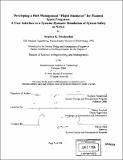Developing a risk management "flight simulator" for manned space programs : a user interface to a system dynamic simulation of system safety at NASA
Author(s)
Friedenthal, Stephen R. (Stephen Roger)
DownloadFull printable version (22.47Mb)
Other Contributors
System Design and Management Program.
Advisor
Nancy Leveson.
Terms of use
Metadata
Show full item recordAbstract
Simulators are a staple of any engineering project and manned space flight in particular. From pilot and crew training to maintenance and emergency repairs, very little is done without it first being thoroughly practiced and refined during advance simulation. Whether the simulation uses a computerized flight simulator that recreates the physics and experience of flight, or a simple mock-up with paper cutouts and hand tools, the end result is the same: people learn to make. better and safer decisions through advanced simulation and practice. However, there are no simulation tools in use to help NASA managers to understand the dynamics of systemic risk, or how to evaluate the inherent risk within an organization. This thesis describes the development of a risk management simulator that will enable NASA managers to explore the dynamics of risk using an advanced system dynamics simulation of the NASA safety culture prior to the Columbia Shuttle accident. This simulation model was developed by MIT Professor Nancy Leveson and her students as part of a NASA USRA research grant and has over 700 variables and several sub models. (cont.) While the model is eminently useful to those familiar with system dynamics, the Vensim software application and the specific model structure, it is not very useful as a learning tool for those who are not. The simulator tool developed for this thesis simplifies and consolidates the overall model behavior into 8 decision variables and 35 display variables. Moreover, 18 of those display variables are grouped into one of 5 categories of "leading indicators" of risk. This simulator enables any user to quickly begin to explore the system model and to discover the consequences of different decisions on system risk, without any need for the user to know system dynamics theory or any details of the model design. In a video game the user doesn't know how it is programmed, but is still able to learn the rules of the game, how it behaves and-most importantly-how to win. Similarly, the goal of the risk management flight simulator is to help NASA managers to learn the rules of system risk, how system risk behaves in response to management decisions, and, most importantly, how to make the best informed risk decisions.
Description
Thesis (S.M.)--Massachusetts Institute of Technology, System Design and Management Program, February 2006. Includes bibliographical references (p. 81-82).
Date issued
2006Department
System Design and Management Program.Publisher
Massachusetts Institute of Technology
Keywords
System Design and Management Program.